
NACA 0012 Acoustic Benchmark
This workflow shows a complex CAA analysis of NACA airfoil using simulation environment TCAE
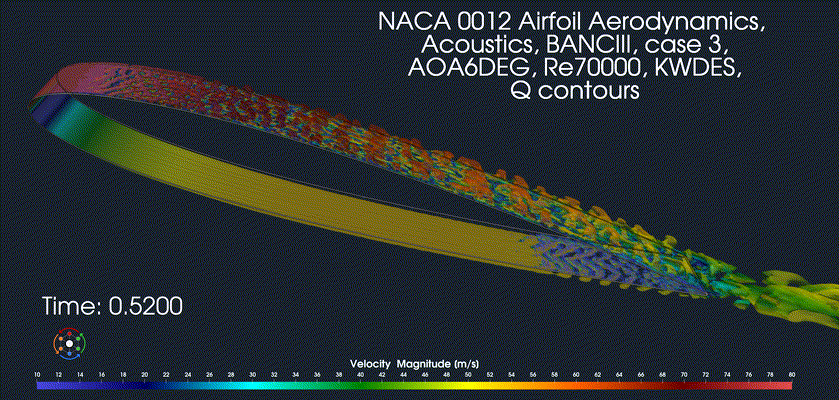
In this project, we delve into the realm of Computational Aero-Acoustics (CAA), focusing on the BANCIIIc3 benchmark [1] of the NACA 0012 airfoil, chord 0.4 m in 3D at 10% span. Employing advanced techniques like the Acoustic Analogy and Ffowcs Williams-Hawkings, we explore the transient simulation of 1s of physical time with Finite Volume CFD simulations in a cell-centered framework. The mesh generation utilizes SnappyHexMesh with 8 inflation layers within the TCAE environment, powered by OpenFOAM. Our study employs the k-ω-SST DES model for a flow with U=53 m/s, Re=70000, and an AOA of 6 degrees. We assess the Sound Pressure Level (SPL) and present Polar plots and backward sound reconstruction. This comprehensive analysis sheds light on the fascinating world of CAA and its applications in aerodynamics.
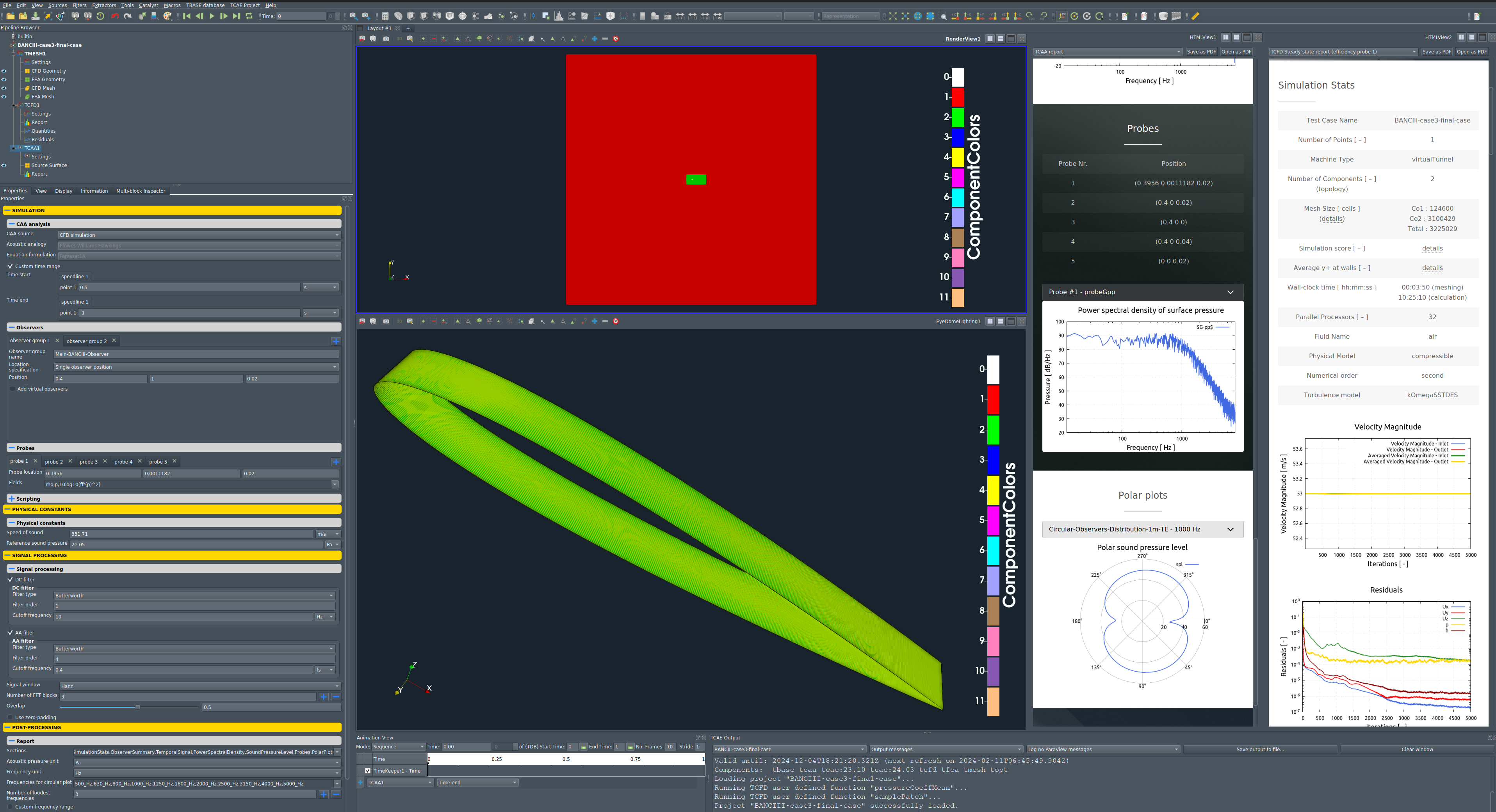
Mesh Topology
The input data is the NACA 0012 airfoil X Y coordinates. The 3D surface geometry is created in Salome open-source software. Any other standard CAD system can be used instead.
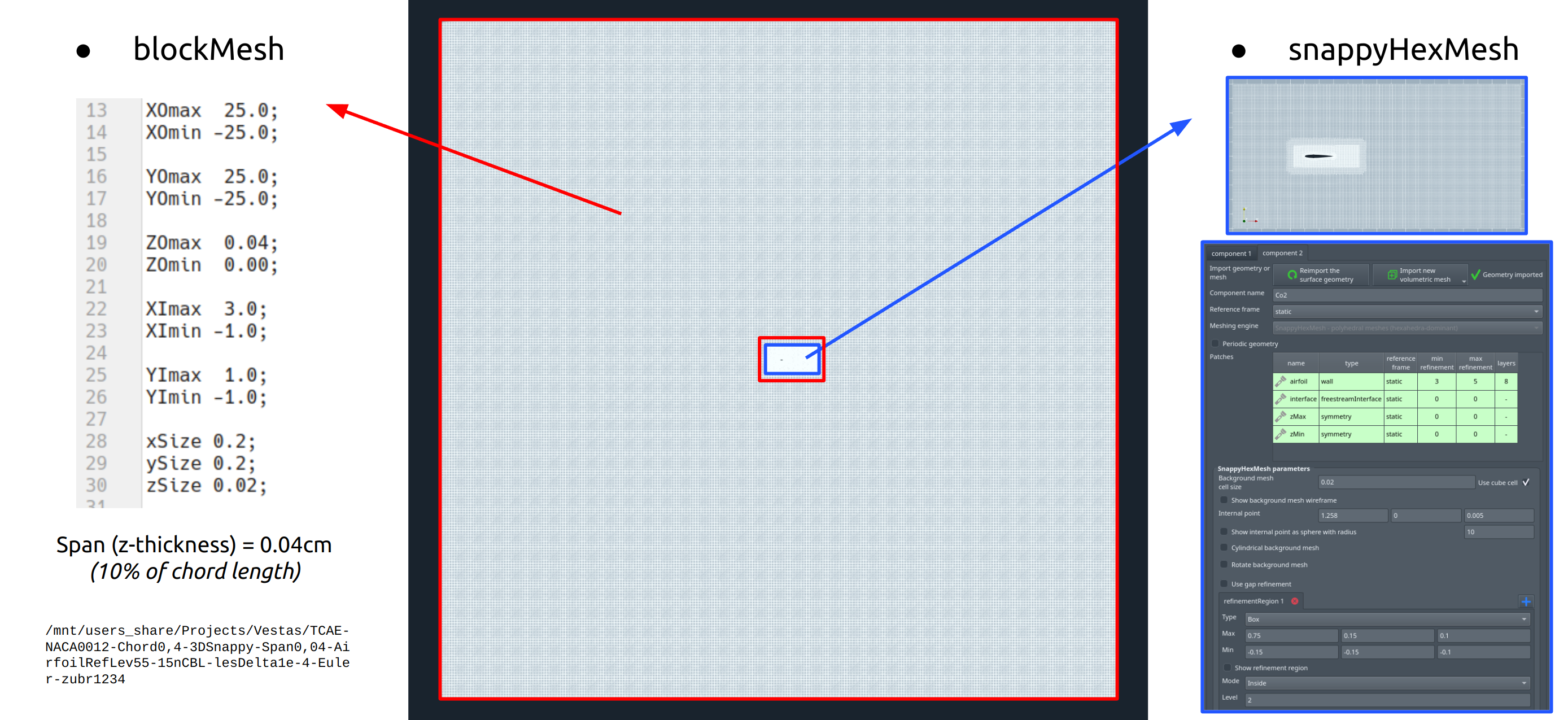
Baseline mesh statistics
- Hexahedra-dominant mesh
- snappyHexMesh
- Domain size: 50x50 [m]
- Number of components: 2 [-]
- Basic cell size in the finer block: 2.5 [mm]
- Freestream Velocity: U=53 [m/s]
- Cells' sizes close to the airfoil: 0.625 [mm]
- Number of inflation layers: 8 [-]
- 64 cells in spanwise direction (span = 40mm ~ 10% chord)
- Overall cell count: 3 100 000 cells
- Y+ min: 0.36 [-]
- Y+ max: 7.6 [-]
CFD Simulation Setup
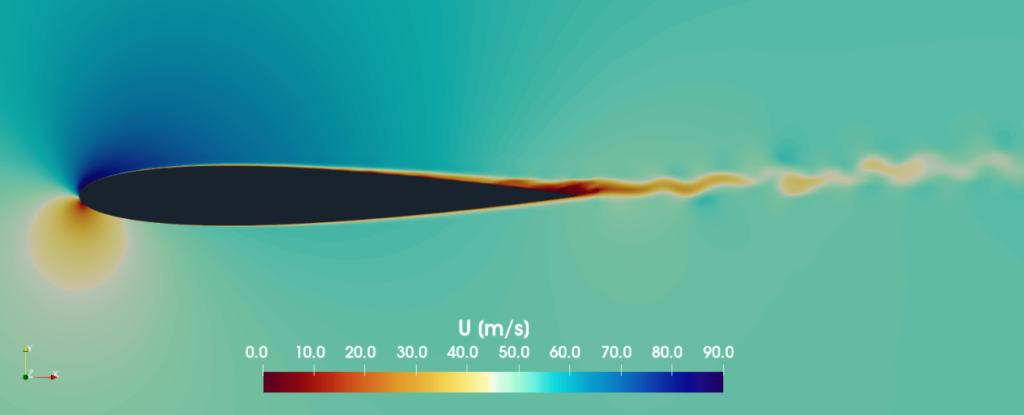
- TCAE Simulation type: Stator
- Time management: transient
- Physical model: Compressible
- Number of components: 2 [-]
- Wall roughness: none
- Freestream Velocity: U=53 [m/s]
- Outlet: 96188 [Pa]
- Turbulence: k-ω-SST DES
- Angle of Attack: 6 DEG
- Shear Thinnig model: Newtonian
- Physical run-time: 1 [s]
- Time step: 5e-5 [s]
- Initial data: Steady-State
- Turbulence intensity: 5%
- Speedlines: 1 [-]
- Simulation points: 1 [-]
- Fluid: Air
- Reference pressure: 1 [atm]
- Dynamic viscosity: 1.719 × 10E-5 [Pa⋅s]
- Air density: 1.224 [kg/m3]
- CFD CPU Time: 600 core.hours/point
- BladeToBlade: off
- Acoustic sampling: T=0.5-1.0 [s]
- Sampling source: Airfoil surface


NACA 0012 BANCIIIc3 Flow Animation

IMPORTANT NOTICE ON PREPROCESSING
The surface of the simulation-ready model has to be clean, simple enough but not simpler! The principles are always the same: the watertight surface model has to be created; all the tiny, irrelevant, and problematic model parts must be removed, and all the holes must be sealed up (the watertight surface model is required). The preprocessing phase is an extremely important part of each simulation workflow. It sets up all the simulation potential and limitations. It should never be underestimated. Mistakes or poor quality engineering in the preprocessing phase can be hardly compensated later in the simulation phase and postprocessing phase. For more details, see the TCAE documentation.
CFD Results Evaluation - Pressure Coefficient - Cp
The Cp coefficient is evaluated from the transient results as a time and spanwise average using automated scripting.
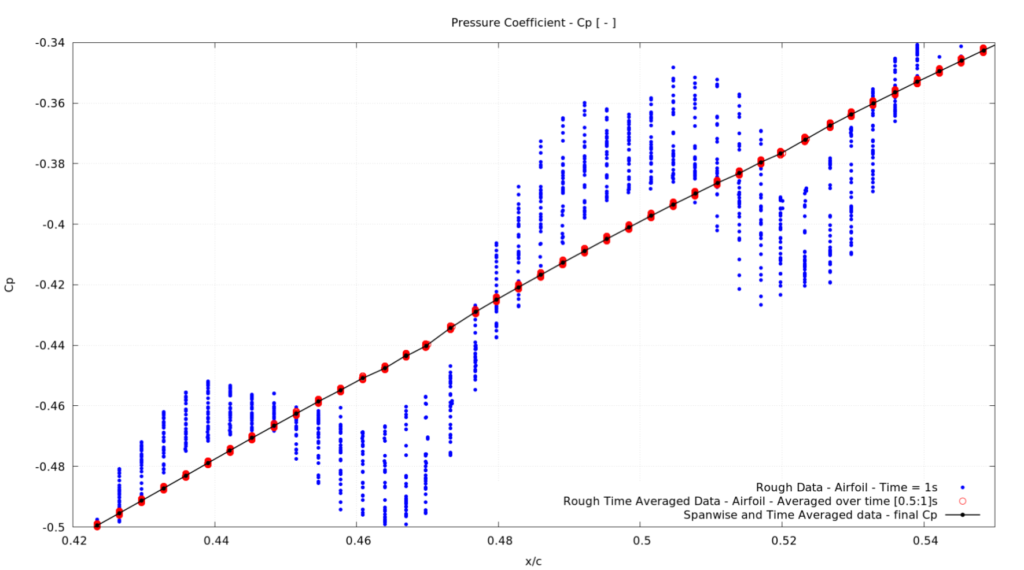
The following plot shows the comparison of the results from the original article [1] and simulation results from steady-state and from averaged transient simulation.
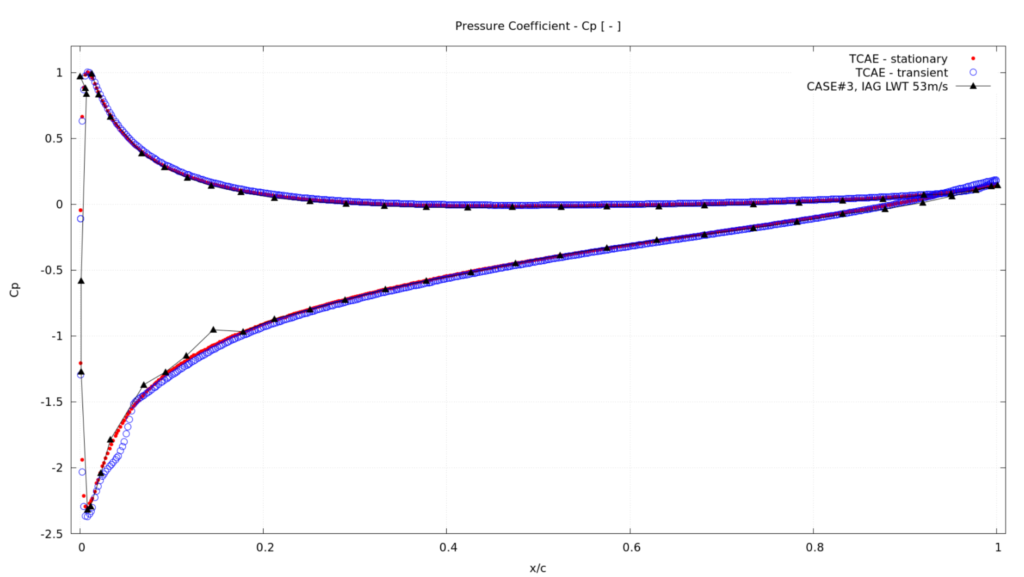
CFD Results Evaluation - Pressure time development
An important part of the project’s results is the evaluation of the time-development of the pressure. The original article [1] shows the data of the pressure evaluated in a single point close to the trailing edge of the airfoil. It’s possible to apply the Fourier transformation to the pressure signal to obtain the power spectral density of the pressure. This allows the evaluation of the time accuracy of the CFD results.
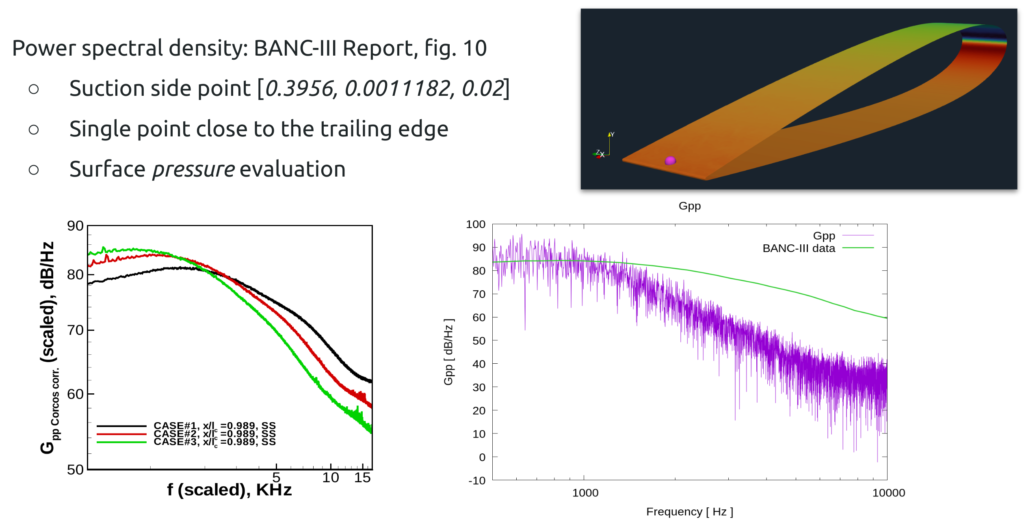
As expected, the measurement data and the simulation data show a good agreement in the lower part of the spectrum. For a good agreement in the high-frequency part of the spectrum, the simulation method would need a much finer spatial resolution (finer mesh) and finer time resolution (lower time-step).
Results Evaluation - CFD Probe vs. Acoustic Observer
Another method to validate the project results is comparing the pressure signal (Probe) in a certain point location with the acoustic pressure evaluated using acoustic analogies (Acoustic Observer – FWH). It’s expected that the frequency spectrums from the probe and from observer should be similar.
There were evaluated three comparisons in three different locations. The first location is close to the trailing edge, still inside the finest level of the volume mesh. Suction side.
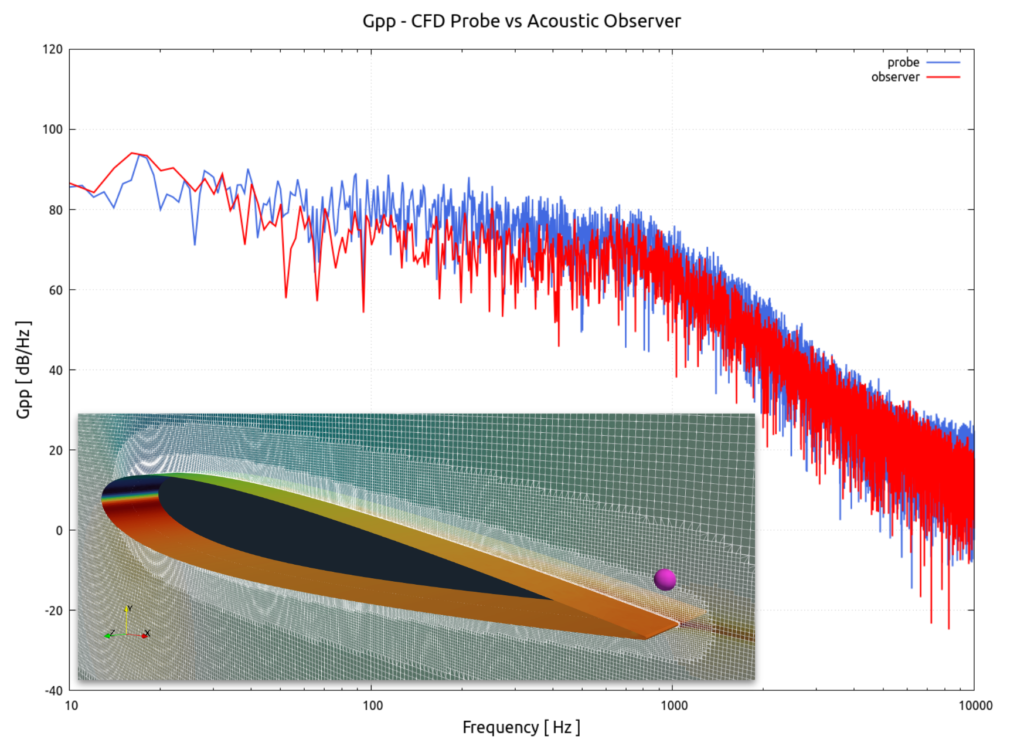
The second location is close to the trailing edge but out of the finest mesh refinement. Suction side.
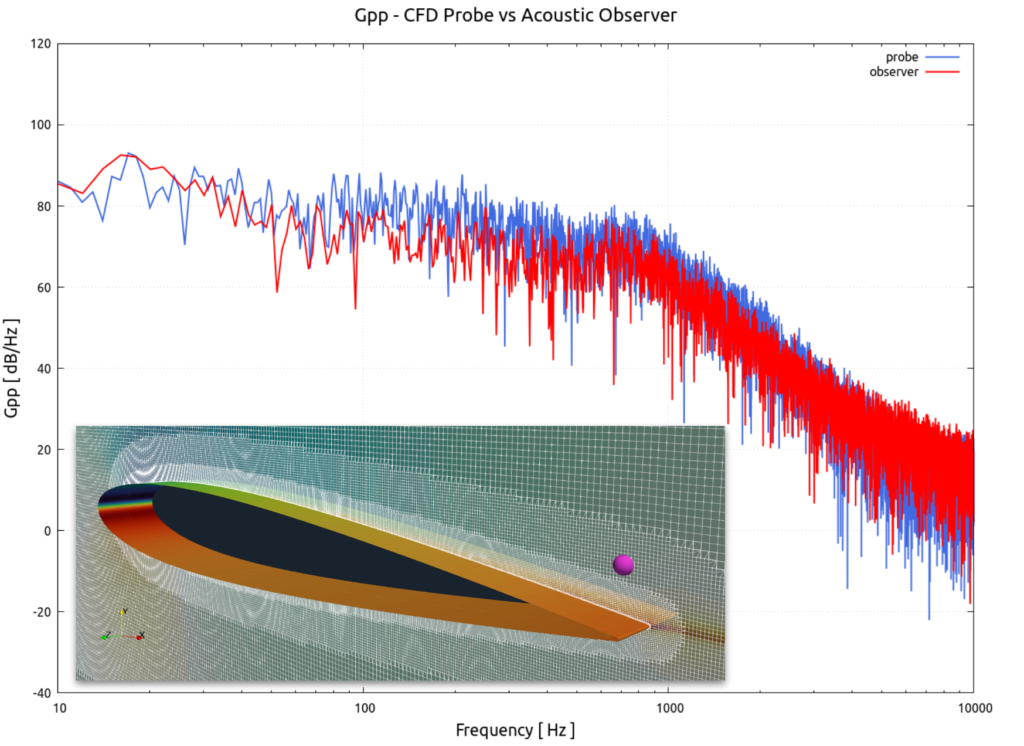
The third location is about in the middle of the airfoil. Suction side.
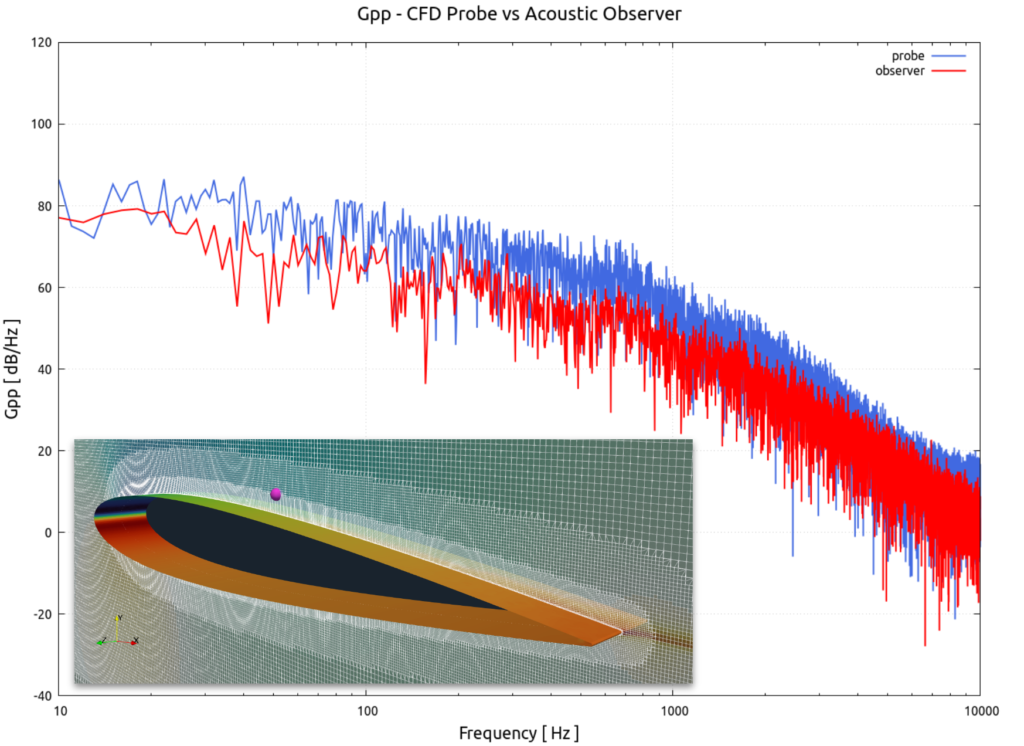
All three comparisons show a good agreement between probe and observer signal.
Acoustic Signal Processing
While the CFD simulation is completely run in the TCFD module. All the acoustics-related settings and later evaluation are done in the TCAA module. A few notes on the signal processing setup:
- The raw signal is centered on the origin and Butterworth filters are applied
- The Welch method is used to transfer the signal to the frequency spectrum
- The signal is divided into three overlapping segments
- On each segment, the Hann window is applied and the Fourier transform is executed
- Transformed segments are reassembled
- PSD and SPL are evaluated from the final signal in the frequency domain
- The current implementation uses the Farassat1A equation formulation of Ffowcs-Williams Hawkings acoustic analogy
- The source data are taken directly from the CFD simulation
- Users can define a custom time range for processing the source data
- Observer is a point in the far field where the acoustic pressure is evaluated by acoustic analogy
- The observer’s location can be also imported from the file to define a more general distribution
- Physical constants define the reference speed of sound and pressure level for 0 dB
- Signal processing can be applied to clear the input data from unwanted noise, oscillation, or data extremes
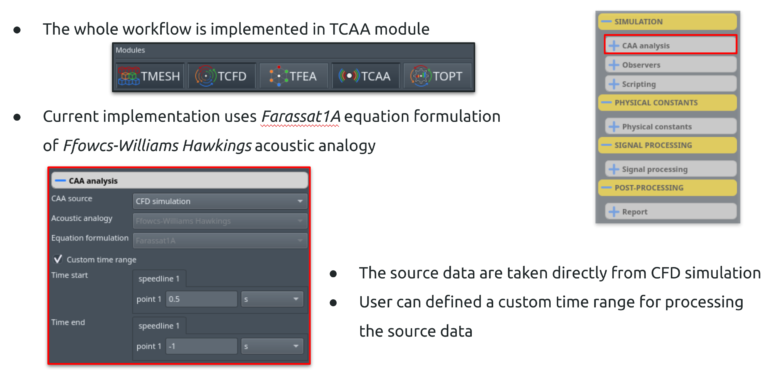
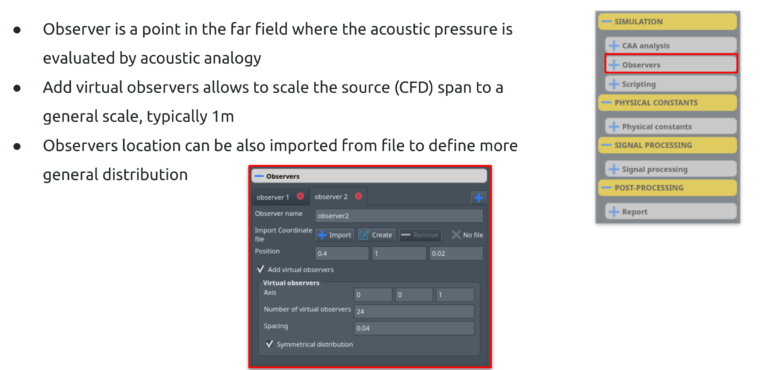
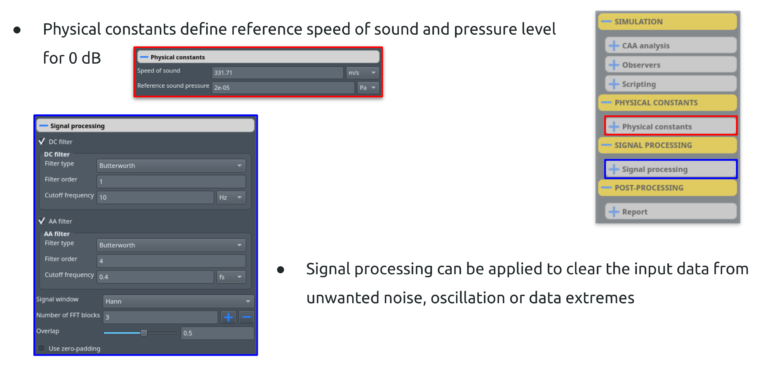
Sound Pressure Level - SPL - Evaluation
One of the main results of the acoustic simulation is the Sound Pressure Level – SPL.
Sound pressure or acoustic pressure refers to the deviation in pressure from the average or equilibrium atmospheric pressure, induced by the presence of a sound wave. This deviation in pressure propagates through a medium, such as air or water, as the sound wave travels, transmitting the auditory information perceived by humans and other organisms. Sound pressure serves as a fundamental metric in the study of acoustics, allowing researchers to quantify the intensity and characteristics of sound waves in various environments and scenarios.
The third-octave band of the Sound Pressure Level (SPL) refers to a graphical representation that breaks down the SPL into its frequency components across different frequency bands. In this representation, the frequency range of interest is divided into octave bands, and each octave band is further subdivided into three equal parts, known as third-octave bands.
Each third-octave band corresponds to a specific range of frequencies, and the SPL within each band is measured or calculated. By analyzing the SPL across these frequency bands, engineers and researchers can gain insights into the frequency distribution of sound energy in a particular environment or from a specific source. This information is valuable for various applications, including noise control, environmental noise assessment, and acoustic design.
Baseline Test Case (8 inflation layers) - BANCIIIc3
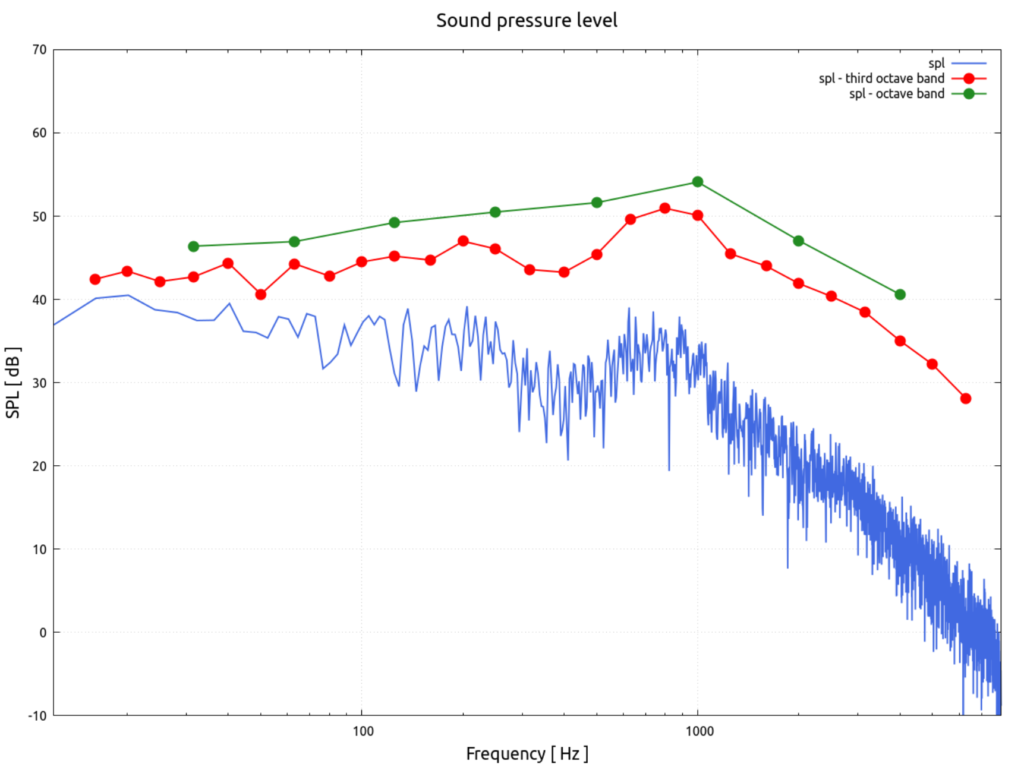
Baseline case with 15 inflation layers - BANCIIIc3
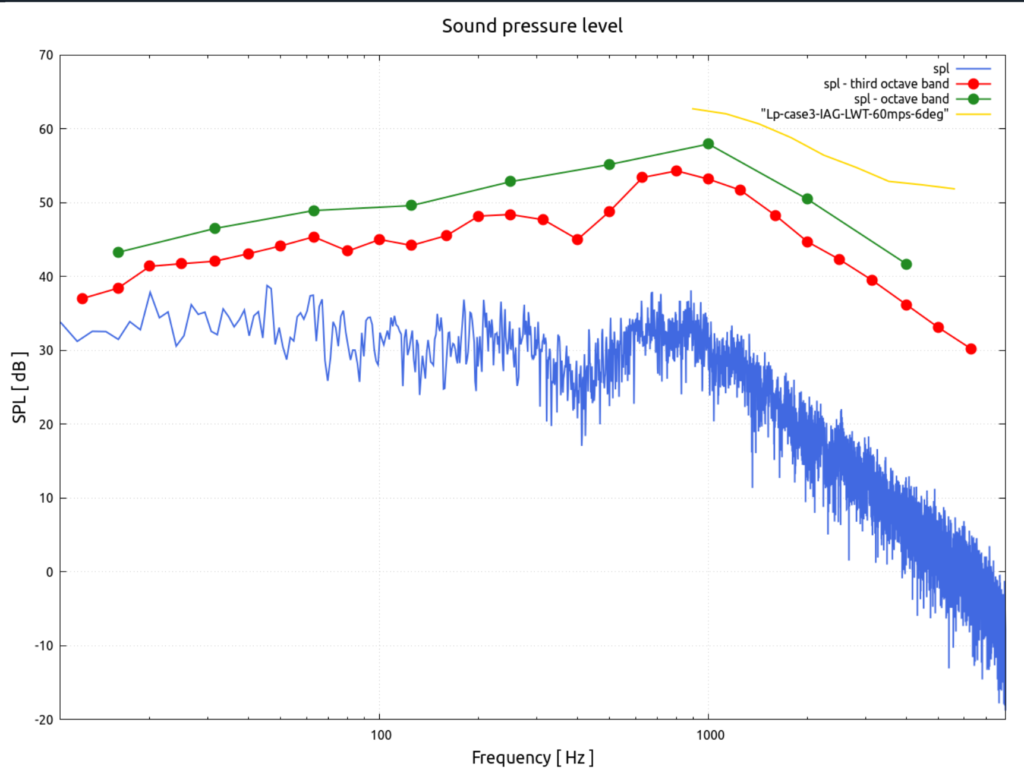
Scaling Results to 1 m span
According to the original article [1], the results should be scaled to a 1m span to ensure the comparability of different simulation results and measurements.
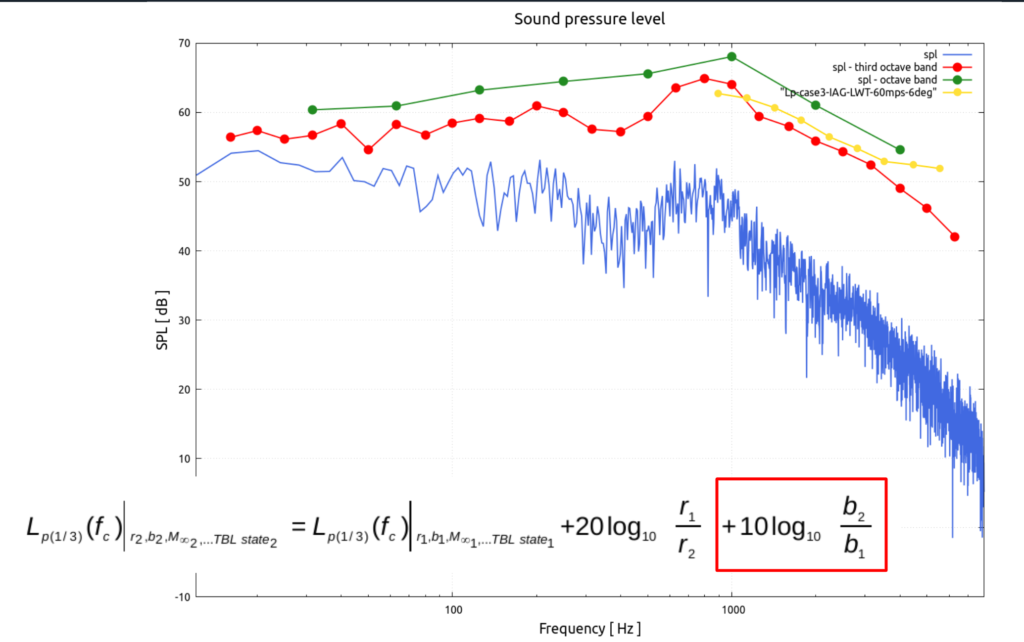
Sound Pressure Level - Polar Plots
Sound Pressure Level (SPL) Polar Plots provide a visual representation of the distribution of sound pressure levels across different directions in a given space.
In these plots, the radial distance (1m) from the airfoil trailing edge represents the distance from the sound source, while the angular direction indicates the direction of measurement. Each point (180 points by 2 degrees) on the plot corresponds to a specific angle and distance from the source.
These plots are particularly useful for analyzing the directional characteristics of sound fields, such as those generated by acoustic sources (airfoil surface). By examining the SPL distribution across various angles, engineers and researchers can gain insights into how sound propagates in different directions from the source, aiding in the design of sound control measures, acoustic treatments, or optimization of noise-reducing devices.
Following plots show the polar plots of SPL for 10 selected frequencies (180 observers regularly distributed on a circle of 1 m radii from the trailing edge).
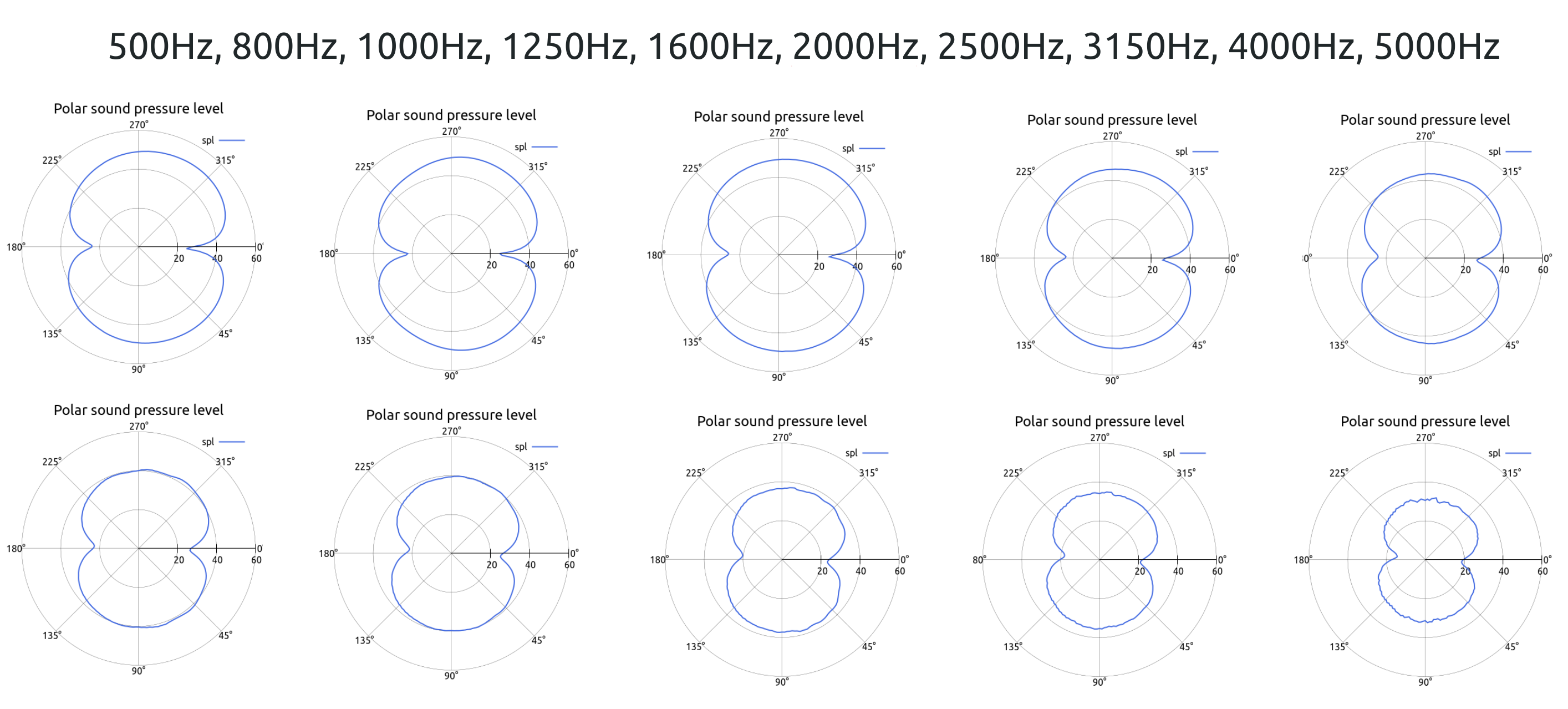
BANCIIIc3 Acoustics Benchmark - animation with sound reconstruction
The following animation shows the Q contours of the fluid flow around the NACA 0012 airfoil, the baseline case. The animation is slowed down about 300 time, while the reconstructed sound is of the real speed.
Conclusion
- It has been shown how to make a comprehensive Computational Aere-Acoustics analysis on an airfoil in a single automated workflow.
- The TCAE results were successfully compared to the measurement data and with other CFD simulation results.
- There was no special tuning used in the CFD simulation at all. There remains a lot of space for tuning CFD methodology, especially for mesh resolution, turbulence modeling, and numerical schemes.
- TCAE has shown to be a very effective tool for Computational Aero-Acoustics simulations
- This benchmark was intentionally written so short not to overwhelm its reader with too many details. The original intention was to show the modern simulation workflow and its accuracy.
- The benchmark details are listed in the references below.
- All the technical details regarding CFD & FEA simulation are listed in the TCAE manual.
- The benchmark geometry and data are freely available for download on the CFDSUPPORT website https://www.cfdsupport.com.
- More information about TCAE can be found on CFD SUPPORT website: https://www.cfdsupport.com/tcae.html
- Questions will be happily answered via email info@cfdsupport.com.
References
[1] Herr, Michaela & Ewert, Roland & Rautmann, Christof & Kamruzzaman, M. & Bekiropoulos, Dimitrios & Iob, Andrea & Arina, Renzo & Batten, Paul & Chakravarthy, Sukumar & Bertagnolio, Franck. (2015). Broadband Trailing-Edge Noise Predictions-Overview of BANC-III Results. 10.2514/6.2015-2847.
[2] TCAA simulation REPORT: https://www.cfdsupport.com/download/report/naca0012-acoustics/TCAAReport.html
[3] https://www.cfdsupport.com/naca-0012-acoustic-benchmark.html
[4] https://en.wikipedia.org/wiki/Sound_pressure
[5] http://www.sengpielaudio.com/calculator-leveladding.htm
[6] https://www.linkwitzlab.com/faq.htm#Q21
[7] http://physics.bu.edu/py231/db3.pdf
[8] TCAE Training
[9] TCAE Manual
[10] TCAE Webinars
Download TCAE Tutorial - NACA 0012 Acoustic Benchmark
File name: NACA-0012-Acoustic-TCAE-Tutorial.zip
File size: 4.3 MB
Tutorial Features: CFD, TCAE, TMESH, TCFD, SIMULATION, COMPRESSIBLE FLOW, STEADY-STATE, AUTOMATION, WORKFLOW, SNAPPYHEXMESH, 2 COMPONENTS, Computational Aero-Acoustics, CAA, BANCIIIc3, Benchmark, NACA 0012, Airfoil, 3D, 10% span, Acoustic Analogy, Ffowcs Williams-Hawkings, Farassat1A, Finite Volume, transient 1s, CFD, Cell-centered, SnappyHexMesh, 8 inflation layers, TCAE environment, OpenFOAM, k-ω-SST DES, U=53 m/s, Re=70000, AOA 6 degrees, SPL, Polar plots, Sound reconstruction
